
Helicoverpa zea, commonly known as the corn earworm, is a species in the family Noctuidae. The larva of the moth Helicoverpa zea is a major agricultural pest. Since it is polyphagous during the larval stage, the species has been given many different common names, including the cotton bollworm and the tomato fruitworm. It also consumes a wide variety of other crops.
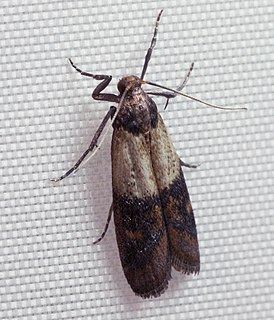
The Indianmeal moth, also spelled as Indian meal moth and Indian-meal moth, is a pyraloid moth of the family Pyralidae. Alternative common names are weevil moth, pantry moth, flour moth or grain moth. The almond moth and the raisin moth are commonly confused with the Indian-meal moth due to similar food sources and appearance. The species was named after being noted for feeding on Indian-meal or cornmeal and it does not occur natively in India as the aberrant usage of Indian meal moth would suggest. It is also not to be confused with the Mediterranean flour moth, another common pest of stored grains.

Hyalophora cecropia, the cecropia moth, is North America's largest native moth. It is a member of the family Saturniidae, or giant silk moths. Females have been documented with a wingspan of five to seven inches (160 mm) or more. These moths can be found all across North America as far west as Washington and north into the majority of Canadian provinces. Cecropia moth larvae are most commonly found on maple trees, but they have also been found on cherry and birch trees among many others. The species was first described by Carl Linnaeus in his 1758 10th edition of Systema Naturae.
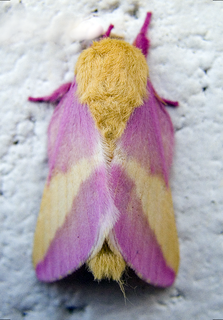
Dryocampa rubicunda, the rosy maple moth, is a small North American moth in the family Saturniidae, also known as the great silk moths. It was first described by Johan Christian Fabricius in 1793. The species is known for its wooly body and pink and yellow coloration, which varies from cream or white to bright pink or yellow. Males have bushier antennae than females, which allow them to sense female pheromones for mating.

Cotinis nitida, commonly known as the green June beetle, June bug or June beetle, is a beetle of the family Scarabaeidae. It is found in the eastern United States and Canada, where it is most abundant in the South. It is sometimes confused with the related southwestern species figeater beetle Cotinis mutabilis, which is less destructive.

Macrodactylus subspinosus is a North American beetle of the family Scarabaeidae. The members of this genus are known as "rose chafers", not to be confused with the European "rose chafer", Cetonia aurata. M. subspinosus occurs from Eastern Canada to Colorado and is considered a pest of many crops and flowers. It is given its common name of rose chafer because it eats the leaves of roses, although it also feeds on many other plants.

Agrotis ipsilon, the dark sword-grass, black cutworm, greasy cutworm, floodplain cutworm or ipsilon dart, is a small noctuid moth found worldwide. The moth gets its scientific name from black markings on its forewings shaped like the letter "Y" or the Greek letter upsilon. The larvae are known as "cutworms" because they cut plants and other crops. The larvae are serious agricultural pests and feed on nearly all varieties of vegetables and many important grains.

Spodoptera littoralis, also referred to as the African cotton leafworm or Egyptian cotton leafworm or Mediterranean brocade, is a species of moth in the family Noctuidae. S. littoralis is found widely in Africa, Mediterranean Europe and Middle Eastern countries. It is a highly polyphagous organism that is a pest of many cultivated plants and crops. As a result, this species was assigned the label of A2 quarantine pest by the EPPO and was cautioned as a highly invasive species in the United States. The devastating impacts caused by these pests have led to the development of both biological and chemical control methods. This moth is often confused with Spodoptera litura.
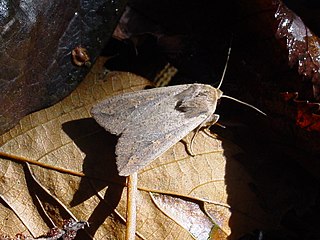
Mythimna unipuncta, the true armyworm moth, white-speck moth, common armyworm or rice armyworm, is a nocturnal agricultural pest belonging to the family Noctuidae. This moth is also commonly referred to by the scientific name Pseudaletia unipuncta. The species was first described by Adrian Hardy Haworth in 1809. Mythimna unipuncta is found in the Americas and in parts of Europe, Africa and Asia. Its original distribution is North and South America. It has been introduced to other places from there. They are known as armyworms because the caterpillars move in lines as a massive group, like an army, from field to field, damaging crops.

Arsenura armida, the giant silk moth, is a moth of the family Saturniidae. It is found mainly in South and Central America, from Mexico to Bolivia, and Ecuador to south-eastern Brazil. It was first described by Pieter Cramer in 1779.

The European chafer is a beetle of the family Scarabaeidae. Formerly found only in continental Europe, this invasive species is now found at temperate latitudes in North America. The large, white grubs of A. majale feed on the roots of most cool-latitude grasses, both wild and cultivated. This has made the European chafer an enemy of lawns.

Cadra calidella, the dried fruit or date moth, is a species of snout moth in the genus Cadra and commonly mistaken for the species Cadra figulilella. It thrives in warmer conditions and is found primarily in Mediterranean countries, although it can also be found in Central Asia, Kazakhstan, Transcaucasia, Caucasus, and the western part of Russia. It feeds on dried fruits, carobs, nuts and seeds, hence earning its colloquial name. This diet damages the food industry, and it is a common storage pest. Because of this, much research has been done to study ways to limit its reproduction rate and population size. It was first described by Achille Guenée in 1845.
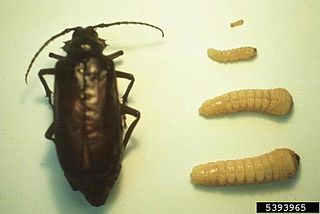
Prionus californicus, commonly known as the California root borer, is a species of insect in the longhorn beetle family (Cerambycidae). It is native to the American west where it is often a pest of orchard and vine crops.

Phyllopertha horticola, the garden chafer or garden foliage beetle, is a beetle from the family Scarabaeidae. Phyllopertha horticola was described by Carl Linnaeus in his landmark 1758 10th edition of Systema Naturae.

Pyronota festiva, commonly known as mānuka beetle or mānuka chafer, is a member of the genus Pyronota of the beetle family Scarabaeidae. It is a scarab beetle endemic to New Zealand, and is commonly found in mānuka trees, hence the beetle's name. In some areas it is considered a pasture pest.

Cyclocephala lurida, the southern masked chafer, is a species of beetle in the family Scarabaeidae which is native to the southeastern United States. It is a brown beetle with a black head, with an adult length of 10 to 14 mm. The adult beetles cause no harm, but the eggs are laid underground and the developing larvae feed on grass roots and can kill turf under dry conditions.
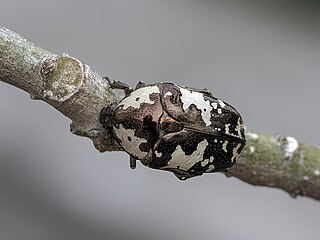
Protaetia aurichalcea is a species of flower-chafer beetle in the family Scarabaeidae. It is found in Asia.
Mallophora ruficauda is a species of parasitic robber fly in the family Asilidae, endemic to South and Central America. Like other robber flies, M. rauficauda is known for its aggressive behavior and predation upon other insects, especially bees. M. ruficauda mimics a bumblebee to fool predators into thinking it has a painful sting and is not worth eating.
Adoretus versutus, commonly known as Rose beetle, is a species of shining leaf chafer found in Afro-Oriental tropics.

Holotrichia reynaudi, is a species of dung beetle found in South India and Sri Lanka.


















